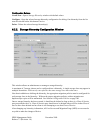
• Auto Stage Retry. When this flag is turned on, and a valid secondary copy of the data exists, and a
stage from the primary copy fails, HPSS will automatically retry the stage using the secondary copy.
• Auto Read Retry. When this flag is turned on, and a valid secondary copy of the data exists, and an
attempt to read the first copy fails, HPSS will automatically retry the read using the secondary copy.
This retry will not be attempted if any data was transferred between the client and HPSS during the
failure.
For Auto Stage Retry and Auto Read Retry to work properly, the COS must contain at
least two copies of the files and at least one valid second copy must have been created
during HPSS migration processing. If any tape storage class in the COS has a migration
policy, that policy must be configured for Migrate Files or Migrate Files and Purge. A
storage class whose migration policy is configured for Migrate Volumes or Migrate
Volumes and Whole Files will not be considered as a valid alternate copy from which
to retry a failed read or stage operation. Any storage class to which such a storage class
migrates, directly or indirectly, will not be considered as a valid retry candidate, either.
•
Truncate Final Segment. A flag to influence whether the final segment of files will be truncated at
file close time in order to save disk space.
When a file is closed, its final segment may be truncated to the smallest segment size which is valid
for the storage class and will still hold the actual data written to the segment. This size will be a
power-of-two multiple of the minimum segment size configured for the storage class. The segment
will later be expanded to its original size if the file is re-opened and new data is written to the segment
or to a point in the file beyond the segment. Truncation of the final segment is performed only on the
file data at the top level of the storage hierarchy and only if the storage class at the top level is disk.
Truncation of the final segment is controlled by the NOTRUNC_FINAL_SEG flag in the bitfile
descriptor; if this flag is off, truncation is performed at file close, and if it is on, truncation is not
performed.
The COS Truncate Final Segment flag influences whether the NOTRUNC_FINAL_SEG flag in the
bitfile descriptor is set at file creation time. The user may specify a creation hint to turn truncation off
even if the COS allows truncation, but he may not turn truncation on if the COS prohibits it. If the
COS Truncate Final Segment flag is on, then at file creation time the NOTRUNC_FINAL_SEG flag
will be set to off, unless the user specifies the NOTRUNC_FINAL_SEG hint. If the COS Truncate
Final Segment flag is off, then the NOTRUNC_FINAL_SEG flag will be set to on at file creation
time, and the user may not override this.
Users may also turn on the NOTRUNC_FINAL_SEG flag in their own files after file creation by use
of the hpss_SetFileNotrunc client api function, but they may not turn off the flag. Authorized callers
may use the hpss_SetFileNotrunc function to turn the flag on or off for any file. Authorized callers
are those such as hpssssm who have CONTROL permission on the core server's Client Interface ACL.
Advice – Truncation of the final segment normally saves disk space. However, if a file is frequently
written, closed, re-opened, and appended to, the repeated truncation and re-expansion of the final
segment could result in fragmentation of the disk, as the space for the expansion is not guaranteed to
be adjacent to the original segment. In addition, it is possible that the only extent available for the
expansion is larger than needed, so some space could actually be wasted.
If it is known that the users of a COS do frequent appends to their files, it is better to turn the COS
Truncate Final Segment flag off to avoid these potential fragmentation and space waste issues. If no
HPSS Management Guide November 2009
Release 7.3 (Revision 1.0) 177


















